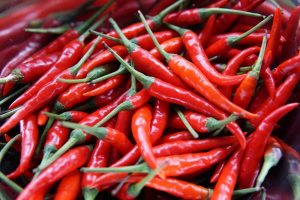 Chile peppers are spicy peppers that can be used to give almost any dish a spicy kick. They taste great in their own right too, and actually have a bunch of health benefits – securing them a place in most people’s spice racks. To learn more about where this flavoring comes from and how to make the most of it, read on.
Chile peppers are spicy peppers that can be used to give almost any dish a spicy kick. They taste great in their own right too, and actually have a bunch of health benefits – securing them a place in most people’s spice racks. To learn more about where this flavoring comes from and how to make the most of it, read on.
History of Chile Peppers
Chile peppers are native to South and Central America and were first introduced to South Asia in the 1500s. Since then, they have grown in popularity to become among the most widely used spices in the world.
While we might use the term chilly to refer broadly to the wide variety of spicy peppers, the truth is that there are actually 25 different species of chilly coming from the Capsicum genus. These range wildly in their potency – from mild and sweet, to blindingly hot. Some Chiles are even dangerous to eat.
Did you know that the spice of a Chile pepper is actually judged by the Scoville heat unit? The higher the number, the spicier the pepper! A bell pepper (sweet and mild) is considered to be between 0-100 – whereas the dangerous Scorpion Trinidad Chile has over 1 million!
However, Chile peppers when eaten correctly can actually be very beneficial for your health. They are beneficial to the immune system, they help to improve digestion, they ease inflammation, and they are high in vitamin C. What’s more, is that like cayenne, they also help to elevate the metabolism and thereby increase fat burn to aid in weight loss.
Uses for Chile Peppers
You can buy Chiles as they are and then use a cutting board and food chopper just as you would with any other fruit of vegetable (Chile is technically a fruit!). However, this method can actually end up harming you if a very hot Chile gets in your eyes. That’s why you might prefer the variety found in your spice racks instead.
There are many ways to use dried Chiles and Chile powers and these are great ways to add some more intrigue to your cooking. Chile peppers found in some curries, but are more commonly associated with recipes out of your Mexican cookbook.
The key tip to keep in mind is that you should not add too much Chile to your sauce pans so as to avoid overpowering. Even if you don’t think that it has made much impact, keep cooking because it can sometimes take a while for the taste to fully develop. So, while you might not notice it right away, there’s a chance you’ll find it hits later!
Another interesting thing to note when using Chile powder or dried Chile peppers, is that your tongue doesn’t actually pick up the ‘taste’ of spice – rather this heat and the flavor comes from a chemical reaction that stimulates the nerves and stimulates the pain receptors. The reaction itself is caused by capsaicin, which is found moreso in the pith. Thus, powder is generally less spicy than the pepper itself! You can also do this yourself of course using your knife block!
There are many ways you can use Chile powder, from making Chile con carne, to using it in your pizza oven, to having it with pasta, to sprinkling it over other ingredients to make them tastier – even canned tuna! Even chocolate can work well with Chile. Grab your apron and get experimenting!
While you’re here, be sure to check out our kitchen product reviews!